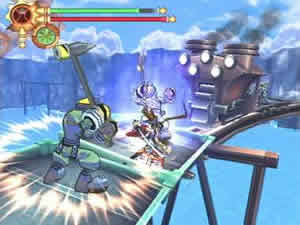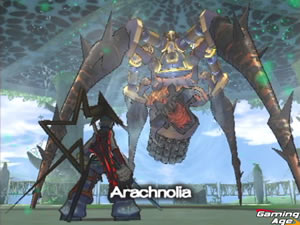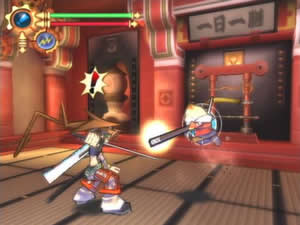Die by the sword.
Musashi Miyamoto was a 16th century samurai who won fame as an unbeatable swordsman, writing the Book of Five Rings and generally beating down Japan’s best blades with naught but a wooden stick. Over the years, many films and anime have been made with characters inspired by the legend of Musashi. Today, this legend lives on in the aptly-titled Musashi: Samurai Legend, a third-person action platformer from Square-Enix.
Unlike the real Musashi, though, Square’s hero is a spiky-haired youth with a taste for baggy pants and his own bare midriff. One day, he is summoned by Princess Mycella to a far away place called Antheum for a traditional hero’s quest. See, after summoning Musashi, the Princess gets captured by the evil President Gandrake, who is trying to take over the world. Your job, then, is to rescue the Princess, defeat Ganon, er Gandrake, and save the Tri-force. Oh wait, no, not the Tri-force, the world. You have to save your girlfriend and the world.
The gameplay mainly consists of button-mashing enemies to death. During combat, Musashi can focus in on an enemy and study his movements. If the focus meter is full, pressing the attack button at just the right moment will allow Musashi to gain a new technique. It’s kind of hit or miss, since you’ll often end up circling enemies and waiting for the indicator to pop up, but at least you can learn more techniques to spice up the incessant mashing.
In addition to his trusty katana, Musashi wields an interesting weapon straight out of the real Miyamoto’s bag of tricks. A giant oar (similar to one rumored to have been used in Musashi’s famous duel with Sasaki Kojiro) can be used for a devastating, albeit very slow, secondary attack. As the game progresses, other special elemental swords become available and each has a special power. The effects of these weapons are usually confined to specific places on the map and generally don’t come into play much during normal combat.
Usually, such simple control schemes benefit from feeling crisp and responsive; there isn’t much for you to do, but at least you have speed on your side. This isn’t the case in Musashi: Samurai Legend. The guy runs so slowly, one wonders if perhaps he’s made of wood. It’s painful.
As if he weren’t slow enough, Musashi sometimes has to rescue weak prisoners. If enemies attack while Musashi is carrying one, he can toss his baggage into the air like a pizza and slash the enemies to ribbons before catching the prisoner again. He can also ditch his wards and come back for them after clearing a path, but that isn’t nearly as cool or suspenseful as tossing malnourished prisoners high up into the air.
 Samurai Legend is primarily a third-person action romp, but Square-Enix has managed to work in some fake RPG elements, too. After defeating enough enemies, Musashi levels up and adds some numbers to his stats, automatically. The enemies get tougher, too, so your hero is simply scaling with the difficulty of the game. So why show us the attributes at all? If we see them, we want to tweak them!
Samurai Legend is primarily a third-person action romp, but Square-Enix has managed to work in some fake RPG elements, too. After defeating enough enemies, Musashi levels up and adds some numbers to his stats, automatically. The enemies get tougher, too, so your hero is simply scaling with the difficulty of the game. So why show us the attributes at all? If we see them, we want to tweak them!
You’ll also wander through Antheum and visit the various shopkeepers you’ve managed to rescue. Food items will restore health and MP, while other items can be used to bolster your stats. But seeing how both HP and MP replenishing items are readily available in the field and only one accessory can be equipped at a time, there isn’t much worth buying.
At least some of the other Anthenians are worth your attention. Some will offer helpful advice, while others may share useful fighting techniques. One of them even runs a fighting arena, where you can pit yourself against groups of enemies or bosses for “fabulous” prizes.
Despite the game’s best efforts (or lack thereof), Samurai Legend is extremely linear. You’ll follow the typical town/dungeon/town format as you make your way through the game. The levels themselves are straightforward and there is always a single path to follow. This is great for kids or people with short attention spans, but those with a taste for adventure will be bummed.
 The majority of the game skims along at an average pace, but a few annoying bits bog everything down. While fighting large mobs, it’s not uncommon to see some of your foes spawn back in before you can dispatch the entire group. Running ahead usually does the trick, but you shouldn’t have to trick a game into playing properly. This game definitely could have used more time in Q&A.
The majority of the game skims along at an average pace, but a few annoying bits bog everything down. While fighting large mobs, it’s not uncommon to see some of your foes spawn back in before you can dispatch the entire group. Running ahead usually does the trick, but you shouldn’t have to trick a game into playing properly. This game definitely could have used more time in Q&A.
Samurai Legend is a cel-shaded game with an anime bend. The man himself, the beasties, and the environments are crisp and colorful, and the aesthetic style, dubbed ‘manga-shading’, is appealing in a bubblegum, DragonBall Z sort of way. Less appetizing are the framerate dips and unruly camera. Instead of locking on, the camera is completely dependent upon the R-stick, making it easy to lose sight of what you’re fighting in the heat of battle.
Samurai Legend‘s voice work is bland and uninteresting with plenty of hokey accents. The music is tinny and annoying and the script makes the bad acting even worse as characters give each other “wicked props.” Did I miss something? Is Antheum in the middle of Boston?
Musashi: Samurai Legends may carry the name of a great samurai, but it’s more of a fungus on the trunk of the family tree than a legitimate heir. There are a few interesting gimmicks, but the crazy camera and spawning enemies are outright annoying and bring dishonor to an otherwise average game. If this is what it means to be a samurai, I’d rather be a ronin.
-
Learned abilities
-
Looks pretty
-
Bad camera
-
Too linear
-
Constant button-mashing







